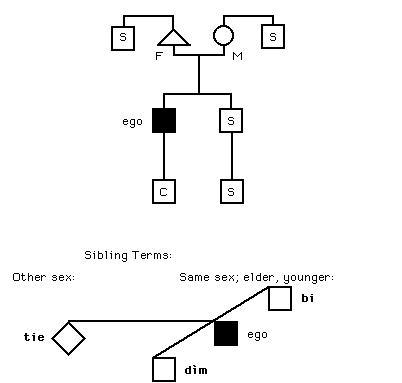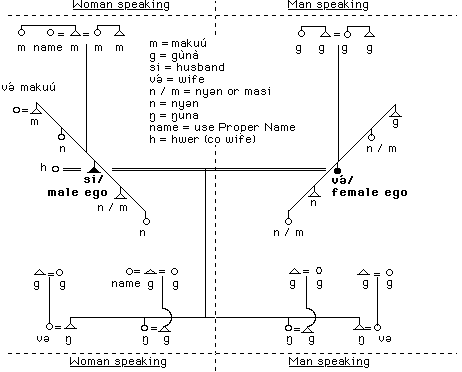DIAGRAM 1 Kinship terminology: summary 
Mambila kinship terminology is bilateral and its use emphasizes relative age rather than generation: except for the lines father, fatherÕs father, mother and motherÕs mother, (and their reciprocals) all other non-affinal kin are Òsiblings Ó. The terminology is hard to classify comprehensibly: according to MurdochÕs cousin-classification it is ÒHawaianÓ, while a classification based on the treatment of the first ascending generation would class it as a ÒlinealÓ terminology (Barnard and Good 1984: 61 ). There remains a problem about motherÕs brother since there is a term for sisterÕs son but no reciprocal. The terminology is as Rehfisch recorded in 1953 with the exception of the increasing use of Fulfulde loan "masi" to distinguish the sex of same-generation affines (see below).
DIAGRAM 1 Kinship terminology: summary 
Key to the diagram:
DIAGRAM 2 AFFINAL TERMINOLOGY 
The affinal terminology differs from that recorded by Rehfisch (1956:122) chiefly in the terms labeled Òn/mÓ which ÒcorrectlyÓ are nyen, but are now often split between nyen and masi in order to distinguish sex. Nyen is used for an affine of the same status and of the same sex as the speaker, while masi, a Fulfulde loan, is used for affines of the same status but of the opposite sex. Some young Mambila are now uncertain about the previous usage of nyen. The dialects of Atta and Sonkolong (but not SomiŽ) use si&egave;r for opposite sex affines of the same status. There are avoidance relationships between a spouse and affines older than the partner, especially their parents, and a joking relationship of badinage with those of a similar age or younger.
Many anthropologists use shorthand conventions for recording kin categories.
The commonest are summarized below:
| Abbreviation | Meaning or gloss |
| F | Father |
| M | Mother |
| Z | Sister |
| B | Brother |
| s | Son |
| d | Daughter |
| e | elder |
| y | younger |